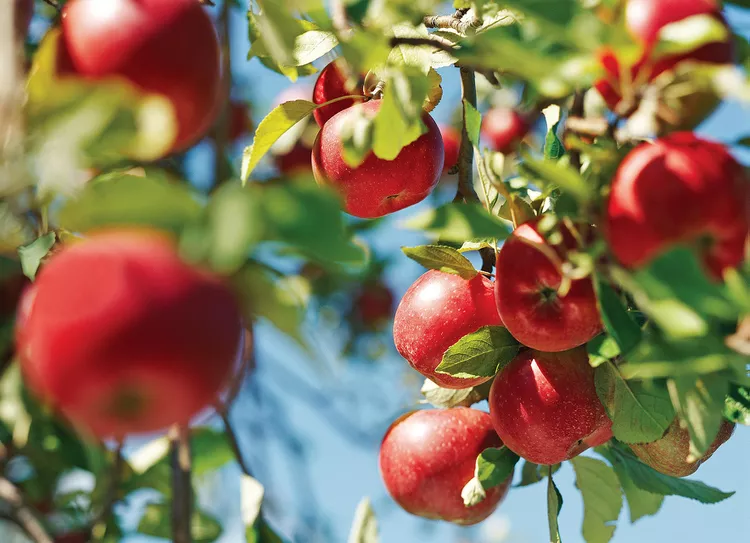Armloads of freshly picked, perfectly ripe apples are an autumn treat. So exactly when is apple picking season? The answer is: it depends. A number of factors—from the variety of apple to recent rainfall to average summer temperature—combine to influence fruit ripening. Some types of apples are ready to harvest as early as July, while others develop their best flavor during the frosty days of autumn, ripening in October or November. Your window for harvesting apples can extend for several weeks or even months with the right mix of varieties. Use these 7 apple picking tips to enjoy this harvest season to its fullest.
1. Know Your Apple Trees
When apple picking from your own backyard orchard, you'll more easily be able to predict when to harvest the fruit if you know the varieties you're growing. Use the variety name to research the harvest window for the tree. This provides a general time when the fruit should be ripe. Keep in mind that the harvest window can vary by several weeks, depending on the weather. Daytime temperatures above 90℉ can speed up ripening by as much as two weeks, while cool, cloudy days will delay fruit maturing.
If you inherited an unknown tree or lost the name over the years, check with your local extension service. Often, there are only about 10 to 15 apple varieties commonly growing in a particular region. It's usually easy to figure out which one an unknown variety may be.
2. Find a Local Orchard
A local orchard is a wonderful place for an apple-picking adventure. To find an orchard near you, ask friends, inquire with vendors at your local farmer's market, and visit orangepippen.com for a list of orchards in your state. If you live near multiple orchards, visit several to experience a variety of apples and the unique flavors, colors, and textures they each offer.
3. Pick Based on Orchard Recommendation
Local orchards often showcase the specific apple varieties that are ready for harvesting. These are the apples that have developed their full flavor and texture. Most orchards grow several apple varieties to have a continuous and changing assortment of apples available for customers from August through late October. If the "ready for picking" varieties are not listed, ask the staff before you head out into the orchard. And if you're growing your own apple tree varieties, finding out when these same varieties are ripe for picking at your local orchards will help you know when to harvest your fruit.
4. Rely on Flavor, Not Color
When picking apples, don't be swayed by eye-pleasing fruit. Some apples develop their mature color before they ripen internally. While the apple skin might be rich red, indicating ripeness, the flesh is still ripening from sour and starchy to sweet and crisp. A taste-test is the best way to check ripeness. A ready-to-pick apple is firm, crisp, juicy, well-colored, and has a flavor characteristic of the variety.
5. Use a Gentle Tug
If an apple is ready to be picked, it should not require a lot of force to pluck from the tree. Gently hold the fruit in the palm of your hand with your thumb near the stem. Then twist and gently lift the apple upward to release the stem from the branch. Aim to harvest apples with their stems attached. An attached stem increases apple storage life. Avoid picking up apples that have fallen to the ground because they may be overly ripe. For fruit that's out of reach, an apple picker can make the job easier.
6. Keep Harvested Apples Cool
After apple picking, your fruit can be stored for weeks. Begin by setting aside any bruised or damaged apples. Bruised apples will cause other nearby apples to degrade more quickly. Refrigerate apples at 34 to 40℉ for long-term storage. Place the fruit in perforated plastic bags to increase humidity around them, but still allow for air flow. Note: apples release ethylene gas as they slowly ripen in refrigeration. The ethylene gas will cause fruits and vegetables sharing the refrigerator to ripen and rot more quickly.
7. Go Back for More
Don't limit yourself to a single apple-picking trip. Visit area orchards every couple of weeks beginning in late August and continuing into November to experience the many flavors of local apples. Apples that ripen later in the season often store well fresh. Or try canning apples or freezing a few so you can enjoy autumn fresh flavors all winter long.
Embrace a long apple season at home by planting varieties that ripen early, mid-, and late season. Fall and spring are good times for planting new trees. Water young, newly planted trees weekly until the ground freezes and look forward to a delicious apple harvest in a few years.




















